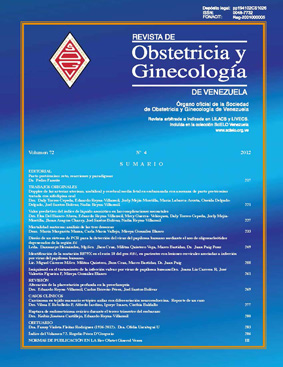Experiencia en el uso del balón SOS Bakri y balón artesanal en la hemorragia posparto por atonia uterina
Palabras clave:
Hemorragia Posparto, Atonía Uterina, Taponamiento Uterino Balón SOS Bakri, Balón Artesanal con Condón, Postpartum Hemorrhage, Uterine Atony, Uterine Tamponade SOS Bakri Balloon, Artisanal Balloon with CondomResumen
Evaluar la efectividad del uso del balón SOS Bakri y del balón artesanal con condón en casos de hemorragia posparto por atonía uterina. Estudio prospectivo que incluyó 12 pacientes con hemorragia posparto por atonía uterina, sin respuesta al tratamiento médico. Se realizó taponamiento uterino con balón SOS Bakri en 6 pacientes y con balón artesanal en 6. Todas recibieron oxitocina, antibioticoterapia y vigilancia de signos vitales y pérdidas hemáticas. Se siguió el protocolo de retiro oportuno. La edad media fue 26±5,58 y 19,66±4,27 años, respectivamente. No se identificó factor de riesgo para atonía uterina en 10 pacientes; una presentó embarazo gemelar con ruptura prematura de membranas y una polihidramnios. La atonía uterina se presentó transcurridos 10±3,33 minutos desde el parto y el taponamiento se practicó a una media de 15,55±6,82 minutos del diagnóstico. El tratamiento con balón artesanal fue exitoso en todos los casos. En el grupo de balón de Bakri, una paciente ameritó histerectomía periparto inmediata. La duración media del taponamiento fue 7±3,09 y 8±0,8 horas respectivamente. Dos pacientes requirieron hemoderivados. La estancia hospitalaria fue de 4±1,09 días para el grupo Bakri y 3,33±0,51 días para el grupo artesanal. La altura uterina a la colocación fue, en promedio, de 20,5±1,87 cm y 20,5±0,54 cm para cada grupo y al retiro fue de 17,33±1,03 cm y 17,66±0,51 cm, respectivamente. No hubo diferencia significativa en los parámetros hemodinámicos. Ambas alternativas de taponamiento reportaron ser útiles y eficaces para reducir el sangrado y tratar la hemorragia posparto.
To evaluate the effectiveness of the use of the SOS Bakri balloon and the handcrafted ball with condom in cases of postpartum haemorrhage due to uterine atoning. Prospective study that included 12 patients with postpartum bleeding for uterine atony, without response to medical treatment. Uterine capping was performed with SOS Bakri balloon in 6 patients and with artisanal balloon in 6. All received oxytocin, antibiotic therapy and surveillance of vital signs and blood losses. The timely withdrawal protocol was followed. The average age was 26-5.58 and 19.66-4.27 years, respectively. No risk factor for uterine atonia was identified in 10 patients; one had twin pregnancy with premature rupture of membranes and polyhydramnios. Uterine atoning occurred within 10 to 3.33 minutes of delivery and plugging was performed at an average of 15.55-6.82 minutes of diagnosis. Handcrafted ball treatment was successful in all cases. In Bakri’s balloon group, a patient warranted immediate peripartum hysterectomy. The average duration of the capping was 7-3.09 and 8-0.8 hours respectively. Two patients required blood products. The hospital stay was 4-1.09 days for the Bakri group and 3.33-0.51 days for the artisanal group. The uterine height at placement was, on average, 20.5–1.87 cm and 20.5–0.54 cm for each group and at retreat was 17.33–1.03 cm and 17.66–0.51 cm, respectively. There was no significant difference in hemodynamic parameters. Both capping alternatives were reported to be useful and effective in reducing bleeding and treating postpartum bleeding.

